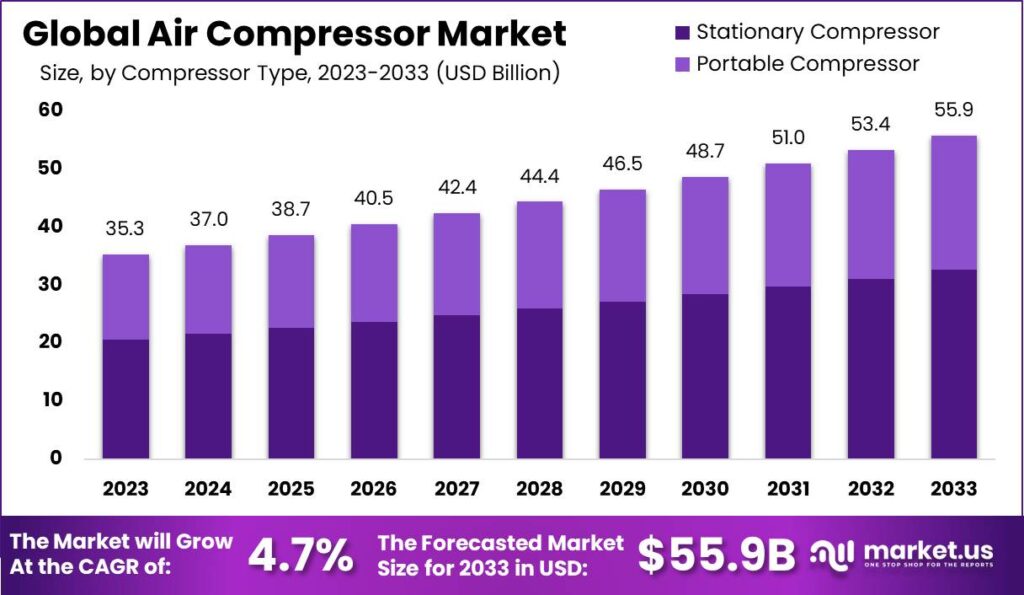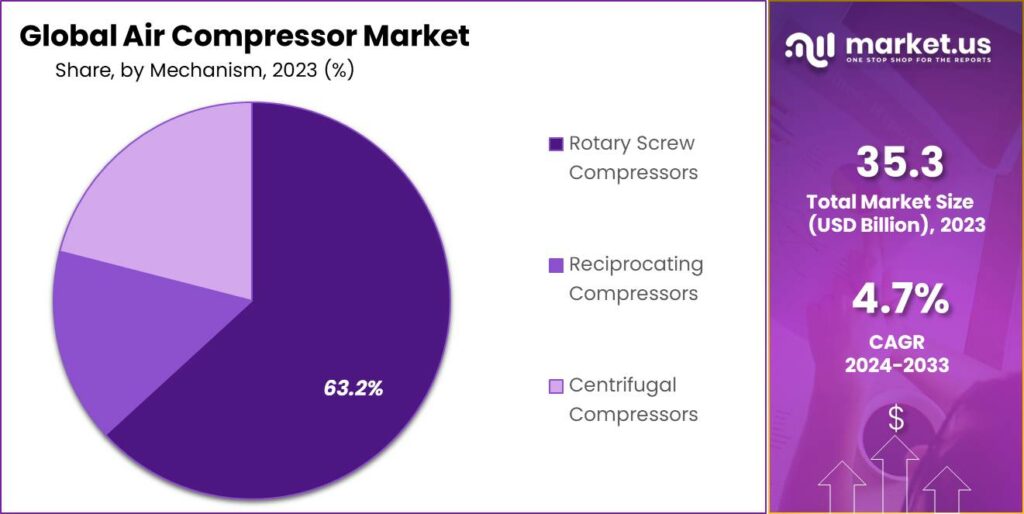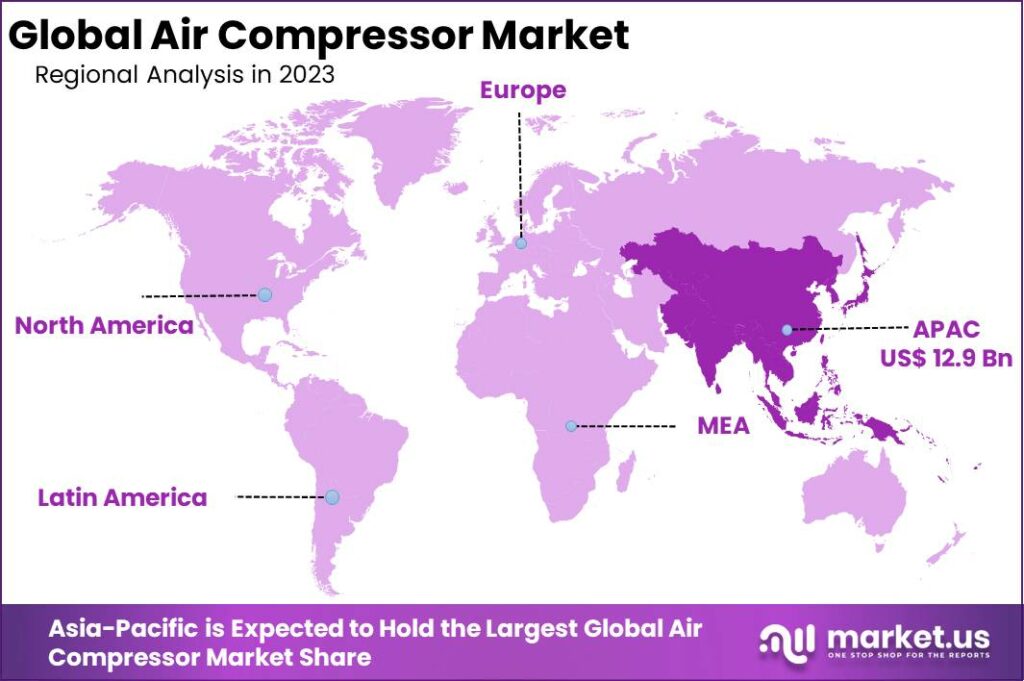Global Air Compressor Market By Compressor Type (Stationary Compressor, Portable Compressor), By Mechanism (Rotary Screw Compressors, Reciprocating Compressors, Centrifugal Compressors), By Lubrication (Oil Filled, Oil Free), By End-Use Industry (Manufacturing, Oil & Gas, Energy & Power, Construction, Food & Beverage, Healthcare, Other End-Use Industries), By Region and Companies - Industry Segment Outlook, Market Assessment, Competition Scenario, Trends and Forecast 2024-2033
- Published date: March 2024
- Report ID: 44624
- Number of Pages: 333
- Format:
- keyboard_arrow_up
Quick Navigation
Report Overview
The Global Air Compressor Market size is expected to be worth around USD 55.9 Billion by 2033, from USD 35.3 Billion in 2023, growing at a CAGR of 4.7% during the forecast period from 2024 to 2033.
An air compressor is a device designed to compress or pressurize air for various applications across different industries. It converts power into potential energy stored in compressed air, which can then be used for tasks ranging from pneumatic tool operation to industrial processes requiring pressurized air. The functionality of air compressors spans across numerous sectors, including manufacturing, automotive, construction, and healthcare, showcasing their versatility and critical role in operational efficiencies.
The air compressor market has experienced steady growth over the years, driven by several factors. One of the key drivers is the increasing industrialization and infrastructure development globally. As industries expand and construction projects rise, the demand for compressed air, which is essential for various operations like powering tools and equipment, pneumatic control systems, and HVAC systems, continues to grow.

Additionally, the automotive industry plays a significant role in driving the air compressor market. Air compressors are vital for automotive manufacturing processes, such as painting, assembly, and pneumatic power tools. As the automotive sector expands and evolves, the demand for air compressors for these applications increases as well.
Moreover, the growing awareness towards energy efficiency and sustainability has influenced the air compressor market. Manufacturers are focusing on developing energy-efficient compressors that reduce power consumption and minimize environmental impact. This shift towards eco-friendly solutions has led to the adoption of advanced technologies like variable speed drives and oil-free compressors.
Key Takeaways
Compressor Type Analysis
In 2023, the Stationary Compressor segment held a dominant position within the air compressor market, capturing more than a 58.4% share. This leadership can be attributed to the segment’s critical role in various industrial operations, where consistent and high-volume air supply is paramount.
Stationary compressors are extensively utilized across industries such as manufacturing, energy, and heavy industry due to their superior capacity, efficiency, and durability compared to portable models. Their ability to deliver a continuous and reliable source of compressed air makes them indispensable in applications requiring high power for prolonged periods, such as in production lines, pneumatic machinery operation, and HVAC systems in large facilities.
The leading position of the Stationary Compressor segment is further reinforced by ongoing industrialization and technological advancements. The development of more energy-efficient and environmentally friendly stationary compressors has prompted industries to invest in these systems to reduce operational costs and comply with stringent environmental regulations.
Additionally, the advent of smart and connected compressors, which offer enhanced monitoring and control capabilities, has increased their attractiveness. The integration of IoT technology enables predictive maintenance, thereby reducing downtime and extending the lifespan of the equipment. As industries continue to focus on optimizing operations and achieving sustainability goals, the demand for stationary compressors is expected to remain robust, underpinning their dominant market share
Mechanism Analysis
In 2023, the Rotary Screw Compressor segment commanded a dominant market position, securing more than a 63.2% share. This segment’s leadership is primarily due to the versatility and efficiency of rotary screw compressors, which are highly favored across a diverse range of industries.
These compressors are renowned for their reliability and ability to provide a steady air supply at constant pressure, which is essential for numerous industrial applications, including automotive, manufacturing, and construction. Their design, which allows for continuous operation without significant wear and tear, contributes to their widespread adoption.
Additionally, the energy efficiency of rotary screw compressors, especially when compared to other types of compressors, plays a critical role in reducing operational costs for businesses, making them a preferred choice for continuous use applications. The prominence of the Rotary Screw Compressor segment is further solidified by technological advancements and the increasing focus on sustainability within industries.
Innovations in design and control systems have led to the development of variable speed rotary screw compressors, which significantly reduce energy consumption by adjusting motor speed to match air demand. This capability not only enhances energy efficiency but also contributes to the reduction of carbon footprint for businesses striving to achieve environmental sustainability goals.
Moreover, the durability and lower maintenance requirements of rotary screw compressors, compared to reciprocating or centrifugal types, ensure their continued popularity. As industries continue to evolve towards more energy-efficient and cost-effective solutions, the demand for rotary screw compressors is expected to maintain its upward trajectory, reinforcing its leading position in the market.

Lubrication Analysis
In 2023, the Oil Filled segment of the air compressor market held a dominant market position, capturing more than a 65.1% share. This significant market share can be attributed to the numerous advantages that oil-filled air compressors offer over their oil-free counterparts.
These advantages include better lubrication, which leads to a longer lifespan for the compressor, enhanced performance due to the cooling properties of oil, and a generally lower level of noise during operation. These factors make oil-filled compressors particularly appealing for industrial applications where reliability and durability are paramount.
The leadership of the Oil Filled segment in the air compressor market is further bolstered by its extensive application across various industries, including manufacturing, construction, and automotive. These sectors require high-powered and reliable compressors for their operations, where the oil-filled variants’ ability to operate continuously for extended periods without significant wear and tear stands out.
Moreover, technological advancements have led to the development of more efficient oil-filled air compressors, minimizing oil leaks and reducing maintenance requirements, thus enhancing their attractiveness to businesses seeking cost-effective and robust solutions for their compressed air needs.
End-Use Industry Analysis
In 2023, the Manufacturing segment held a dominant position in the Air Compressor market, capturing more than a 28% share. This leading status can be attributed to the extensive utilization of air compressors in various manufacturing processes.
Air compressors are integral to operations such as pneumatic tool operation, material handling, and automation systems, which are prevalent across a wide range of manufacturing industries including automotive, electronics, and machinery. The demand for air compressors in the manufacturing sector is driven by the need for efficient, reliable, and clean energy sources to power myriad processes, highlighting the sector’s reliance on compressed air as a vital utility.
The significance of the Manufacturing segment is further underscored by the ongoing technological advancements and the shift towards Industry 4.0, which emphasizes automation and data exchange in manufacturing technologies. Air compressors play a crucial role in enabling these advancements by providing the necessary power for automated machinery and robotic systems.
Moreover, the push for sustainability and energy efficiency in manufacturing practices has led to the adoption of advanced air compressor systems designed to reduce energy consumption and minimize environmental impact. This trend towards energy-efficient and technologically advanced air compressors is expected to continue propelling the growth of the Manufacturing segment within the Air Compressor market.
Key Market Segments
Compressor Type
- Stationary Compressor
- Portable Compressor
Mechanism
- Rotary Screw Compressors
- Reciprocating Compressors
- Centrifugal Compressors
Lubrication
- Oil Filled
- Oil Free
End-Use Industry
- Manufacturing
- Oil & Gas
- Energy & Power
- Construction
- Food & Beverage
- Healthcare
- Other End-Use Industries
Regional Analysis
In 2023, Asia-Pacific held a dominant market position in the Air Compressor market, capturing more than a 36.5% share. This commanding presence is largely due to the region’s rapid industrialization, significant investments in infrastructure development, and the expansion of manufacturing capabilities across various industries. Asia-Pacific is home to some of the world’s largest manufacturing hubs, including China, India, and Japan, which collectively contribute to the region’s high demand for air compressors. These devices are critical for a myriad of applications ranging from automotive and electronics manufacturing to food processing and construction, making them indispensable in the region’s industrial landscape.
The Asia-Pacific region’s lead in the air compressor market is further bolstered by its growing focus on renewable energy projects, which require heavy-duty air compressors for operations and maintenance. Additionally, the region’s emphasis on enhancing energy efficiency and reducing carbon footprint has led to the adoption of advanced air compressor technologies that offer higher efficiency and lower environmental impact. Governments across the region have introduced regulations and incentives to promote the use of energy-efficient industrial machinery, which in turn is driving the demand for innovative air compressor solutions.
Moreover, the surge in infrastructure projects, including the development of smart cities and transportation networks across the Asia-Pacific region, has significantly increased the need for reliable and efficient air compressors in the construction sector. This demand is expected to continue growing as the region focuses on improving its industrial base and infrastructure to support economic growth. The strategic initiatives by key players in the air compressor market to expand their presence in Asia-Pacific through partnerships, mergers, and acquisitions, are indicative of the region’s potential for sustained market leadership.

Key Regions and Countries Covered in this Report:
- North America
- The US
- Canada
- Europe
- Germany
- France
- The UK
- Spain
- Italy
- Russia
- Netherland
- Rest of Europe
- APAC
- China
- Japan
- South Korea
- India
- New Zealand
- Singapore
- Thailand
- Vietnam
- Rest of Asia Pacific
- Latin America
- Brazil
- Mexico
- Rest of Latin America
- Middle East & Africa
- South Africa
- Saudi Arabia
- UAE
- Rest of MEA
Top Market Leaders
- Atlas Copco AB
- Ingersoll Rand Inc.
- Doosan Group
- Hitachi, Ltd.
- Kaeser Kompressoren SE
- Elgi Equipments Limited
- Kobe Steel, Ltd.
- ABAC International
- AireTex Compressors
- Bauer AG
- BelAire Compressors
- MAT Holdings, Inc.
- Other Key Players

- Atlas Copco AB. Company Profile
- Ingersoll Rand Inc.
- Doosan Group
- Hitachi, Ltd.
- Kaeser Kompressoren SE
- Elgi Equipments Limited
- Kobe Steel, Ltd.
- ABAC International
- AireTex Compressors
- Bauer AG
- BelAire Compressors
- MAT Holdings, Inc.
- Other Key Players
- Nestlé S.A Company Profile
- settingsSettings
Our Clients
| Single User $4,599 $3,499 USD / per unit save 24% | Multi User $5,999 $4,299 USD / per unit save 28% | Corporate User $7,299 $4,999 USD / per unit save 32% | |
|---|---|---|---|
| e-Access | |||
| Report Library Access | |||
| Data Set (Excel) | |||
| Company Profile Library Access | |||
| Interactive Dashboard | |||
| Free Custumization | No | up to 10 hrs work | up to 30 hrs work |
| Accessibility | 1 User | 2-5 User | Unlimited |
| Analyst Support | up to 20 hrs | up to 40 hrs | up to 50 hrs |
| Benefit | Up to 20% off on next purchase | Up to 25% off on next purchase | Up to 30% off on next purchase |
| Buy Now ($ 3,499) | Buy Now ($ 4,299) | Buy Now ($ 4,999) |












